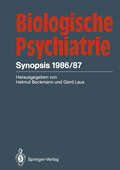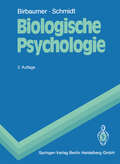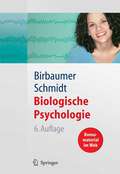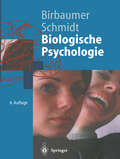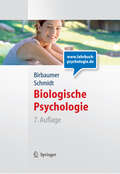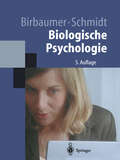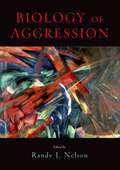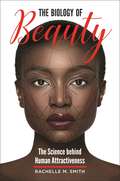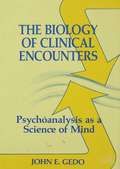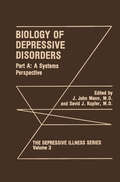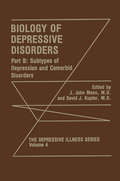- Table View
- List View
Biologie des Geistesblitzes - Speed up your mind!
by Henning BeckDenken Sie, das Gehirn ist eine perfekte Rechenmaschine, die evolutionäre Krone aller Informationssysteme, die komplexeste Struktur des Universums, präziser und leistungsfähiger als jeder Computer? Vergessen Sie das sofort! Das Gehirn ist ein Haufen voller eitler, fauler und selbstverliebter Zellen, die sich ständig verrechnen und dabei noch permanent von ihren Nachbarn abgelenkt werden.Da hält man es kaum für möglich und doch geschieht das Wunder: Das Gehirn funktioniert! Sehr gut sogar, denn Menschen sind im Gegensatz zu rechnenden Maschinen ausgesprochen kreativ.„Wie das?“, mag man fragen und dieses Buch gibt die Antwort darauf. Fachlich fundiert und locker aufbereitet berichtet der deutsche Science Slam-Meister 2012 Henning Beck über das Zusammenspiel von Nerven- und ihren Helferzellen, erklärt, was ein Geistesblitz überhaupt ist, wie er entsteht und was die Hirnforschung zum Thema Kreativität zu sagen hat.
Biologische Korrelate der Angst bei psychiatrischen Erkrankungen (Monographien aus dem Gesamtgebiete der Psychiatrie #67)
by Margot AlbusBiologische Marker bei affektiven Erkrankungen (Monographien aus dem Gesamtgebiete der Psychiatrie #45)
by Helmfried E. KleinBiologische Psychiatrie: Forschungsergebnisse
by P. Baumann J. Fleischhauer W. Janke B. Küferle D. Ploog B. Saletu1. Dreiländer-Symposium für Biologische Psychiatrie, zugleich 3. Kongreß der Deutschen Gesellschaft für Biologische Psychiatrie. Lindau, 27.-29. September 1984
Biologische Psychiatrie: Synopsis 1986/87
Dieser Band enthält die teilweise überarbeiteten Beiträge zum 4. Kongreß der Deutschen Gesellschaft für Biologische Psychiatrie 1986 in Würzburg. Die Beiträge behandeln die Pathomorphologie endogener Psychosen, psychobiologische Modelle affektiver Erkrankungen, operationalisierte Diagnostik, periphere Marker endogener Psychosen, senile Demenz, klinische Themen, neuropsychobiologische Grundlagen, Psychoendokrinologie, apparative Methoden und die Psychopharmakotherapie.
Biologische Psychiatrie der Gegenwart: 3. Drei-Länder-Symposium für Biologische Psychiatrie Lausanne, September 1992
by W. W. Fleischhacker W. Gaebel G. Laux H. J. Möller B. Saletu B. WoggonDieser Band vereint die wissenschaftlichen Beiträge zum 3. Dreiländersymposium für Biologische Psychiatrie. Damit spiegelt er den gegenwärtigen Stand der Forschung auf dem Gebiet im deutschsprachigen Raum dar. Auffallend ist der stark interdisziplinäre Charakter dieser Veranstaltung, die Psychiater, klinische Pharmakologen, Psychologen, Statistiker, Genetiker, Immunologen und Vertreter der "Neurosciences" vereinigt und Themen der Erwachsenen-, aber auch der Kinder- und Gerontopsychiatrie behandelt. Das Buch ist nach den Hauptthemen gegliedert: Biochemie der Schizophrenie, Chronobiologie und Schlaf, bildgebende Verfahren und Elektrophysiologie, Verlaufsparameter, Opiatabhängigkeit, Kinder-, Jugend- und Gerontopsychiatrie, klinische Psychopharmakologie, neurologische Softsigns, Behandlung und Prophylaxe von affektiven Psychosen, Genetik und Immunologie der Geisteskrankheiten, Psychoneuroendokrinologie. Die 200 Beiträge illustrieren den Aufschwung der biologischen Psychiatrie und sind ein Zeugnis für die intensive Forschung auf diesem Gebiet.
Biologische Psychologie (Springer-Lehrbuch)
by Niels Birbaumer Robert F. SchmidtDer große Erfolg machte bereits nach kurzer Zeit eine Neuauflage notwendig. Die verbesserte 2. Auflage bietet eine übersichtliche und umfassende Einführung in die biologischen und physiologischen Grundlagen des Verhaltens: Von der Einzelzelle bis zu den Denkprozessen wird der neueste Wissensstand dargestellt. Das Gehirn wird dabei nicht nur als biologische Größe betrachtet, die psychisches Erleben und Verhalten "hervorbringt", sondern als ein in ständigem Austausch mit den Umweltgegebenheiten und den vererbten Eigenschaften befindliches dynamisches System. Die didaktisch übersichtliche Darstellung mit zahlreichen hervorragenden Abbildungen erleichtert sowohl dem Anfänger den Einstieg als auch dem Fortgeschrittenen die Aktualisierung seines Wissens. Das Buch ermöglicht somit nicht nur eine ökonomische Prüfungsvorbereitung, sondern führt den Leser zu einem Verständnis des komplexen Zusammenwirkens physiologischer Gesetzmäßigkeiten mit Verhaltensprinzipien.
Biologische Psychologie (Springer-Lehrbuch)
by Niels Birbaumer Robert F. SchmidtDas spannende Fachgebiet Biologische Psychologie erforscht die Zusammenhänge zwischen biologischen Prozessen und Verhalten. Dabei werden die Lebensprozesse aller Organe des Körpers, nicht nur des Gehirns, betrachtet. Das erfolgreiche Lehrbuch "Biologische Psychologie" liefert hier einen lebendigen und anschaulichen Gesamtüberblick sowohl der Physiologie als auch der Physiologischen Psychologie. Die biologischen Grundlagen unseres Verhaltens werden von physiologischen Prozessen bis zu komplexen Funktionen des ZNS, wie Bewusstsein, Motivation und Kognitionen, beschrieben. die engen Beziehungen zwischen "Kopf und Körper" verdeutlichen die Autoren in anschaulicher Weise. Die 6. Auflage wurde komplett überarbeitet und mit lernfreundlicher Didaktik ausgestattet, so dass das Lehrbuch eine unverzichtbare Grundlage für Prüfungsvorbereitung und Studium ist. Hervorgehobene Merksätze und Kapitelzusammenfassungen kennzeichnen prüfungsrelevantes Wissen. Zahlreiche Exkurse und Boxen stellen den Anwendungsbezug her. Die komplett überarbeiteten und durchgehend farbigen Abbildungen veranschaulichen das Zusammenwirken von Verhaltensprinzipien und physiologischen Gesetzmäßigkeiten.
Biologische Psychologie (Springer-Lehrbuch)
by Niels Birbaumer Robert F. SchmidtDas erfolgreiche Lehrbuch bietet eine umfassende Einführung in die biologischen Grundlagen des Verhaltens. Von der Einzelzelle bis zu den Denkvorgängen des Menschen wird der neueste Wissenstand dargestellt. Das Gehirn wird dabei nicht nur als biologische Größe betrachtet, die psychische Prozesse hervorbringt, sondern als ein in ständigem Austausch mit den Umweltgegebenheiten und den vererbten Eigenschaften befindliches dynamisches System. Das Buch besticht durch seine systematische Gliederung und konsequente Didaktik. Jedes Kapitel enthält Einleitungen, strukturierende Überschriften und knappe Zusammenfassungen der wesentlichen Lerninhalte. Somit ermöglicht es nicht nur eine ökonomische Prüfungsvorbereitung, sondern führt den Leser zu einem Verständnis des komplexen Zusammenwirkens von Verhaltensprinzipien und physiologischen Gesetzmäßigkeiten.
Biologische Psychologie (Springer-Lehrbuch)
by Niels Birbaumer Robert F. SchmidtDas spannende Fachgebiet Biologische Psychologie erforscht die Zusammenhänge zwischen biologischen Prozessen und Verhalten. Dabei werden die Lebensprozesse aller Organe des Körpers, nicht nur des Gehirns, betrachtet. Das erfolgreiche Lehrbuch "Biologische Psychologie" liefert hier einen lebendigen und anschaulichen Gesamtüberblick sowohl der Physiologie als auch der Physiologischen Psychologie. Es beschreibt die biologischen Grundlagen unseres Verhaltens, von physiologischen Prozessen bis zu komplexen Funktionen des ZNS, wie Bewusstsein, Motivation und Kognitionen, sowie die engen Beziehungen zwischen "Kopf und Körper" in anschaulicher Weise. Die 7. Auflage wurde komplett überarbeitet und um ein neues Kapitel zu Entwicklungsprozessen im Alter ergänzt. Das Lehrbuch ist aufgrund der lernfreundlichen Didaktik eine unverzichtbare Grundlage für Prüfungsvorbereitung und Studium: Hervorgehobene Merksätze und Kapitelzusammenfassungen kennzeichnen prüfungsrelevantes Wissen. Zahlreiche Exkurse und Boxen stellen den Anwendungsbezug her. Die durchgehend farbigen Abbildungen veranschaulichen das Zusammenwirken von Verhaltensprinzipien und physiologischen Gesetzmäßigkeiten. Die begleitende Website bietet zusätzliche Lerntools für Studierende und Materialien für Dozierende.
Biologische Psychologie (Springer-Lehrbuch)
by Niels Birbaumer Robert F. SchmidtBiologische Psychologie, das erfolgreiche Lehrbuch von Robert F. Schmidt und Niels Birbaumer, liegt in der 5. Auflage vor. Die biologischen Grundlagen unseres Verhaltens werden von physiologischen Prozessen bis zu komplexen Funktionen des ZNS, wie Bewusstsein, Motivation und Kognitionen, beschrieben. Neue Methoden der Biopsychologie und aktuelle Forschungsergebnisse wurden ergänzt. Die Didaktik des Lehrbuches macht es zu einer unverzichtbaren Grundlage für Prüfungsvorbereitung und Studium. Kapitelzusammenfassungen und Infoboxen kennzeichnen prüfungsrelevantes Wissen. Zahlreiche Abbildungen veranschaulichen das Zusammenwirken von Verhaltensprinzipien und physiologischen Gesetzmäßigkeiten.
Biologische Psychologie (Basiswissen Psychologie)
by Erich SchrögerBiologische Psychologie (oder Biopsychologie) ist eines der zentralen Teilgebiete der Psychologie. Während Psychologie ganz allgemein als die Wissenschaft vom Erleben und Verhalten des Menschen definiert ist, erforscht die Biologische Psychologie speziell die biologischen Grundlagen bzw. Korrelate unseres Erlebens und Verhaltens. Dieses Lehrbuch vermittelt einen Einblick in ausgewählte Methoden und Inhalte des Faches. So wird beispielsweise gezeigt, wie wir unser Gehirn beim „Arbeiten“ beobachten können, und es wird erläutert, inwiefern uns der Schlaf beim Lernen hilft.
Biologische Psychologie (Basiswissen Psychologie)
by Erich Schröger Sabine Grimm Dagmar MüllerBiologische Psychologie (oder Biopsychologie) ist eines der zentralen Teilgebiete der Psychologie. Während Psychologie ganz allgemein als die Wissenschaft vom Erleben und Verhalten des Menschen definiert ist, erforscht die Biologische Psychologie speziell die biologischen Grundlagen bzw. Korrelate unseres Erlebens und Verhaltens. Dieses Lehrbuch vermittelt einen Einblick in ausgewählte Methoden und Inhalte des Faches. So wird beispielsweise gezeigt, wie wir unser Gehirn beim „Arbeiten“ beobachten können, und es wird erläutert, inwiefern uns der Schlaf beim Lernen hilft.
Biologische Psychologie: Ein Überblick für Psychologiestudierende und -interessierte (Was ist eigentlich …?)
by Erich Schröger Gesa HartwigsenDieses Lehrbuch aus der Reihe „Was ist eigentlich …?“ gibt einen kurzen Überblick über das Fach "Biologische Psychologie". Es möchte Psychologiestudierenden am Beginn des Studiums Orientierung bieten bei der Frage, was wichtig ist und worauf es in dem Fach wirklich ankommt. Es bietet aber auch für alle anderen an psychologischen Themen Interessierten einen ersten, gut verständlichen Einblick in Konzepte, Inhalte und Methoden des Fachs: Es zeigt auf, worum es es bei der Biopsychologie im Kern geht. An ausgewählten Beispielen werden prominente Fragestellungen der Vergangenheit und Gegenwart anschaulich behandelt, die uns auch künftig beschäftigen werden.
Biology of Aggression
by Randy J. NelsonUnchecked aggression and violence take a significant toll on society. Even if we manage to avoid being the direct victim of a violent act, the effects of aggression and violence reach us all: We hear about the mauling of a woman by an aggressive dog, our children are bullied at school, or we deal with impulsive violence while commuting to work or attending a sporting event. Reflecting psychology in general, the dominant roles of learning and environmental influences - both social and nonsocial - have traditionally been prominent in discussions of the etiology of human aggression. Biological factors have not been considered sufficiently important to investigate in the search for ways of dealing with human aggression or violence. With recent advances in pharmacology and genetic manipulation techniques, however, new interest has developed in the biological mechanisms of both non-human and human aggression. Although aggression is certainly a complex social behavior with multiple causes, molecular biological factors should not be overlooked, as they may well lead to interventions that prevent excess aggressive behaviors. The primary goal of this book is to summarize and synthesize recent advances in the biological study of aggression. As most aggressive encounters among human and non-human animals represent a male proclivity, the research in this book describes and discusses studies using the most appropriate murine model: testosterone-dependent offensive inter-male aggression, which is typically measured in resident-intruder or isolation-induced aggression tests. The research also emphasizes various molecules that have been linked to aggression tests. The research also emphasizes various molecules that have been linked to aggression by the latest gene-targeting and pharmacological techniques. Although the evidence continues to point to androgens and serotonin (5-HT) as major hormonal and neurotransmitter factors in aggressive behavior, recent work with GABA, dopamine, vasopressin, and other factors, such as nitric oxide, has revealed significant interactions with the neural circuitry underlying aggression. This book is organized according to levels of analysis. The first section examines the genetic contributions to aggression in species ranging from crustaceans to humans. The section summarizes the involvement of various neurotransmitters and neuromodulators in aggressive behavior. The third section summarizes the influence of hormones on aggression, primarily in humans. All chapters emphasize future directions for research on aggression and reveal important domains that have received comparatively less attention in this literature. Considered together, these chapters provide up-to-date coverage of the biology of aggression by some of the leading authorities currently working in this field. Biology of Aggression will direct future research to continue the recent advances in the pharmacological and genetic approaches to understanding aggression and violence. It promises to be a valuable resource for professional and student researchers in neuroscience, psychiatry, cognitive and developmental psychology, behavioral biology, and veterinary medicine.
Biology of Aggression
by Randy J. NelsonUnchecked aggression and violence take a significant toll on society. Even if we manage to avoid being the direct victim of a violent act, the effects of aggression and violence reach us all: We hear about the mauling of a woman by an aggressive dog, our children are bullied at school, or we deal with impulsive violence while commuting to work or attending a sporting event. Reflecting psychology in general, the dominant roles of learning and environmental influences - both social and nonsocial - have traditionally been prominent in discussions of the etiology of human aggression. Biological factors have not been considered sufficiently important to investigate in the search for ways of dealing with human aggression or violence. With recent advances in pharmacology and genetic manipulation techniques, however, new interest has developed in the biological mechanisms of both non-human and human aggression. Although aggression is certainly a complex social behavior with multiple causes, molecular biological factors should not be overlooked, as they may well lead to interventions that prevent excess aggressive behaviors. The primary goal of this book is to summarize and synthesize recent advances in the biological study of aggression. As most aggressive encounters among human and non-human animals represent a male proclivity, the research in this book describes and discusses studies using the most appropriate murine model: testosterone-dependent offensive inter-male aggression, which is typically measured in resident-intruder or isolation-induced aggression tests. The research also emphasizes various molecules that have been linked to aggression tests. The research also emphasizes various molecules that have been linked to aggression by the latest gene-targeting and pharmacological techniques. Although the evidence continues to point to androgens and serotonin (5-HT) as major hormonal and neurotransmitter factors in aggressive behavior, recent work with GABA, dopamine, vasopressin, and other factors, such as nitric oxide, has revealed significant interactions with the neural circuitry underlying aggression. This book is organized according to levels of analysis. The first section examines the genetic contributions to aggression in species ranging from crustaceans to humans. The section summarizes the involvement of various neurotransmitters and neuromodulators in aggressive behavior. The third section summarizes the influence of hormones on aggression, primarily in humans. All chapters emphasize future directions for research on aggression and reveal important domains that have received comparatively less attention in this literature. Considered together, these chapters provide up-to-date coverage of the biology of aggression by some of the leading authorities currently working in this field. Biology of Aggression will direct future research to continue the recent advances in the pharmacological and genetic approaches to understanding aggression and violence. It promises to be a valuable resource for professional and student researchers in neuroscience, psychiatry, cognitive and developmental psychology, behavioral biology, and veterinary medicine.
The Biology of Alcoholism: Volume 2: Physiology and Behavior
by Benjamin Kissin Henri BegleiterAlcoholism is a uniquely human condition. Although some forms of alcohol dependence can be induced experimentally in a variety of laboratory animals, the complete spectrum of alcoholism with all of its physical, psychological, and social implications occurs only in man. The special quality of this relationship becomes more significant when one considers that the manifestations of most physical disease syndromes in animals and man are more similar than they are different. The uniqueness of alcoholism lies in the fact that it is one of the few physical diseases which reflects at all levels the problems of individuals coping with the complexities of human society. In order to present a more coherent picture of these complex relationships, we have attempted to impose a logical sequence upon the material. This sequence lies along a dual parameter-from the physical to the social and from the theor etical to the empirical. Consequently, it was natural for the first volume in this series to deal with biochemistry, the most basic and physical aspect of the inter action of alcohol and man. It is equally natural for this, the second volume, to deal with physiology and behavior, for these levels of phenomenology-partic ularly the latter-are already more empirical and psychological in their mani festations. Finally, the third volume, clinical pathology, describes the disease itself, with all of the medical and social implications carried in the word "alcoholism.
The Biology of Alcoholism: Volume 3: Clinical Pathology
by Benjamin Kissin Henri BegleiterIn this volume, the third of our series, the emphasis has shifted from the theoretical and experimental to the more clinical and practical aspects of alcoholism. Where, in the earlier volumes, more attention was directed to animal than human studies, in this volume, almost all material deals with the human condition. The clinical manifestations of alcoholism may be divided into two major aspects, that of the disease itself and that of its complications. This separation is to some extent artificial since, in a sense, the natural history of the disease is a function of the development of certain complicating mechanisms. These mechanisms in turn either become part and parcel of the underlying condition -alcoholism-or give rise to a new set of clinical variables characterized as "medical complications. " At this point, the dichotomy becomes real. The disease alcoholism tends to be seen as a distinct psychosocial entity and to be treated with psychosocial techniques. The "medical complications" are more clearly envisioned as being within the legitimate domain of medical practice and are treated by physicians who often tend to ignore the underlying alcoholism. The "patient" is sometimes lost in between. The major thrust of this volume is an attempt to describe the mechanisms of alcoholism as they are now known, in such a way as to establish a continuum between the disease alcoholism and its "medical complications.
The Biology of Beauty: The Science behind Human Attractiveness
by Rachelle M. SmithThis thought-provoking book examines the science behind human attractiveness—the ratios, proportions, and other factors that to a large extent dictate what we find "beautiful."It's said that "beauty is in the eye of the beholder," but recent scientific research suggests that human attractiveness is much more objective than we once thought, deeply rooted in our biology and evolutionary history. For instance, facial symmetry is considered extremely attractive because it indicates good health and nutrition during the formative developmental years. This book explores these insights.Part I of The Biology of Beauty: The Science behind Human Attractiveness takes a closer look at what traits we find the most alluring and why. It discusses why attractiveness is important from an evolutionary standpoint and the advantages (and disadvantages) of being attractive. In addition to exploring these beauty "universals," it examines how beauty ideals can be shaped by factors such as culture, religion, and the media. Part II provides an in-depth analysis of individual features that contribute to attractiveness, offering scientific explanations for our preferences. The book also includes a collection of insightful sidebars that highlight beauty ideals in different parts of the world and at other times in history.
The Biology of Beauty: The Science behind Human Attractiveness
by Rachelle M. SmithThis thought-provoking book examines the science behind human attractiveness—the ratios, proportions, and other factors that to a large extent dictate what we find "beautiful."It's said that "beauty is in the eye of the beholder," but recent scientific research suggests that human attractiveness is much more objective than we once thought, deeply rooted in our biology and evolutionary history. For instance, facial symmetry is considered extremely attractive because it indicates good health and nutrition during the formative developmental years. This book explores these insights.Part I of The Biology of Beauty: The Science behind Human Attractiveness takes a closer look at what traits we find the most alluring and why. It discusses why attractiveness is important from an evolutionary standpoint and the advantages (and disadvantages) of being attractive. In addition to exploring these beauty "universals," it examines how beauty ideals can be shaped by factors such as culture, religion, and the media. Part II provides an in-depth analysis of individual features that contribute to attractiveness, offering scientific explanations for our preferences. The book also includes a collection of insightful sidebars that highlight beauty ideals in different parts of the world and at other times in history.
The Biology of Clinical Encounters: Psychoanalysis as a Science of Mind
by John E. GedoIn The Biology of Clinical Encounters, Gedo utilizes recent findings in neuroscience and cognitive psychology to elaborate his conception of psychobiology and to consider its implications in clinical analysis. He pursues this challenging undertaking in several directions. He illuminates the way in which psychobiology enters into his hierarchical model of mental functioning, and goes on to examine three clinical syndromes - phobias, obsessions, and affective disturbances - in which biological considerations are particularly important. Of special note are chapters examining the implications of a biological approach for clinical psychoanalysis. Gedo explores the notion of transference that grows out of attentiveness to psychobiological factors, elaborates the concept of therapeutics that follows from looking beyond mental contents, and discusses the problem of assessing clinical evidence produced by analyses informed by a psychobiological orientation. Drawing on his own analytic work of over three decades, he compares analyses conducted with a psychobiological orientation with the outcome of analyses conducted earlier in his career with a more traditional psychological approach. A stimulating introduction to the interpenetration of the biological and the psychological in clinical work, The Biology of Clinical Encounters is quintessential Gedo: scholarly in conception, elegant in tone, provocative in import, and illuminating, always, of fundamental issues about the status of psychoanalysis as a science of mind.
The Biology of Clinical Encounters: Psychoanalysis as a Science of Mind
by John E. GedoIn The Biology of Clinical Encounters, Gedo utilizes recent findings in neuroscience and cognitive psychology to elaborate his conception of psychobiology and to consider its implications in clinical analysis. He pursues this challenging undertaking in several directions. He illuminates the way in which psychobiology enters into his hierarchical model of mental functioning, and goes on to examine three clinical syndromes - phobias, obsessions, and affective disturbances - in which biological considerations are particularly important. Of special note are chapters examining the implications of a biological approach for clinical psychoanalysis. Gedo explores the notion of transference that grows out of attentiveness to psychobiological factors, elaborates the concept of therapeutics that follows from looking beyond mental contents, and discusses the problem of assessing clinical evidence produced by analyses informed by a psychobiological orientation. Drawing on his own analytic work of over three decades, he compares analyses conducted with a psychobiological orientation with the outcome of analyses conducted earlier in his career with a more traditional psychological approach. A stimulating introduction to the interpenetration of the biological and the psychological in clinical work, The Biology of Clinical Encounters is quintessential Gedo: scholarly in conception, elegant in tone, provocative in import, and illuminating, always, of fundamental issues about the status of psychoanalysis as a science of mind.
Biology of Depressive Disorders. Part A: A Systems Perspective (The Depressive Illness Series #3)
by David J. Kupfer J. JohnMannThis volume is the third in a series on depressive illness. The first volume, entitled Phenomenology of Depressive Illness, is devoted to a de scription of depressive illness from a variety of perspectives that include those of the patient, the clinician, and the psychiatric researcher. It de scribes the major subtypes of depressive illness and places them in the context of the life cycle. The second volume in this series is entitled Models of Depres sive Disorders: Psychological, Biological, and Genetic Perspectives. This volume describes several major models of depressive disorders, in cluding genetic, cognitive, interpersonal, intrapsychic, and neurobio logical models. The third and fourth volumes deal with the biology of affective disorders in detail. These volumes are distinguished by a triaxial ap proach. In Volume III the biology of affective disorders is described from the perspective of individual transmitter systems and neurophysi ologic and biologic processes. In Volume IV the biology of depression is addressed from the vantage point of symptom components of de pression, and similarities and differences in the biology of depression are described compared to other psychiatric disorders with clinically overlapping features such as anxiety disorders or eating disorders. The effects on biology of comorbid conditions such as anxiety, personal ity disorders, alcoholism, and eating disorders are reviewed. These ap proaches incorporate issues of state versus trait.





